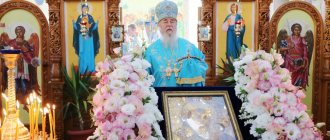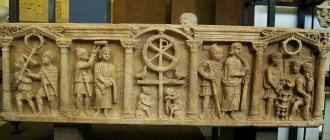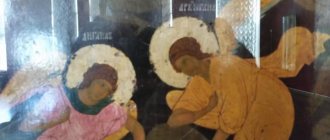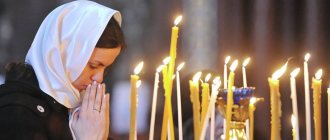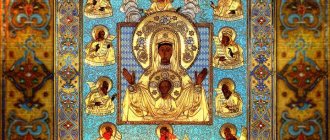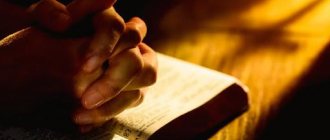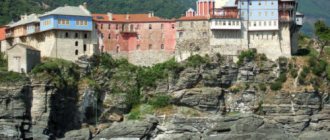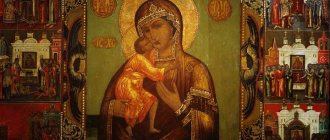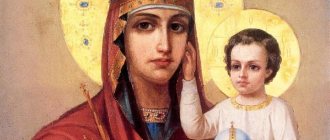The image of the Lord and Savior Jesus Christ is the most important icon in every home. This is an image of God Himself, incarnate and accepting death on the Cross for the sake of people.
There are a number of iconographies of Jesus Christ, many miracles are known from His ancient and new icons. What is the meaning of the iconographic type of Christ the Savior Pantocrator, how to pray to the Lord?
Dear Brothers and Sisters, we will be very glad if you subscribe to our group in, there you will find even more prayers, icons and other interesting information, here is the address link - Orthodox group! We are also pleased to remind you that on the pages of our church store you can find all possible Orthodox goods!
Description and history of origin
Despite its historical value for the entire Christian world, no one knows the exact date of painting of the icon. What is known is that the image for painting the icon was the “Savior Not Made by Hands,” which appeared during the life of Jesus Christ. This continued until the 4th century, until icon painters began to depict Jesus Christ in the guise of a young youth, appearing before a worshiper surrounded by his apostles.
Later, the style of painting the icon changed again, and now Jesus is depicted as a man, wise over the years, with a long, neat beard. In one hand he holds a book, the other is extended to the congregation in a blessing gesture.
Over the entire history of the religion, many variations of the “Lord Pantocrator” icon have been created, where the Son of God was depicted in full growth, waist-deep, and even seated on a throne.
Note! One of the oldest images of Jesus Christ is kept in the Sinai Monastery. On it, the Son of God appears before believers in the image of the Heavenly King and Judge.
What does the Pantocrator icon mean?
This image is recognizable to people, since a halo and a cross are depicted above the image of Christ. This halo indicates the heavenly origin and the second earthly hypostasis of God. The cross symbolizes victory over death and sin, the patience that Jesus Christ showed during his torment.
The best article for you, go to: Icon “Mammal” of the Mother of God, meaning and how it helps
Among a large number of icons, his image is shown in six main types, which are divided into 20 subtypes. “Savior Not Made by Hands,” “Lord Almighty,” and “Lord on the Throne” are some of the most famous and recognizable images familiar to every Christian.
Meaning in Orthodoxy
In Orthodoxy, Jesus Christ personifies the image of Pantocrator or Savior Almighty. The Almighty Himself endowed him with the power to judge people according to their deeds, seating him on the Heavenly Throne. The icon “Lord Almighty” reminds parishioners of the importance of good deeds and that everyone awaits the Heavenly Judgment, during which everyone will be rewarded according to their deserts. The face of Jesus calls to lead a righteous and measured life, free from sinful thoughts.
Description of the meaning of the iconographic image
Jesus is sinless by nature, which is why he shouldered the entire burden of worldly sins. Jesus was convicted and sentenced to crucifixion, thus atoning for all the sins of the people. He is a representative of the Holy Trinity, namely the Son who descended to Earth and, through the action of the Holy Spirit, was born from a woman, thereby taking on the form of a man.
Mostly in the icons depicting Jesus Christ Pantocrator, glimpses of divine light are visible flowing from within him. Taking this aspect into account, we can say that the icons show not just the physical state, but also the spiritual essence, and therefore reveal to the viewer the divine nature of Jesus.
The icon of the Lord Pantocrator is, on the one hand, a unit of religious art, and on the other hand, a whole iconographic type of image of the Lord God. It should be understood that the icon of God the Father Almighty is non-canonical, since the Almighty is not generally depicted in Orthodoxy; only Jesus and symbolically the Holy Spirit are depicted.
What does it help with?
The icon helps against many troubles and misfortunes, among which are the following:
- sinful thoughts;
- injuries, both spiritual and physical;
- protects from death and troubles;
- protects from deception and disappointment;
- protects against vile actions and human cruelty;
- helps in finding harmony if your spirit is in turmoil;
- helps save marriage;
- eliminates misunderstandings between people;
- transforms protracted conflicts into peaceful channels;
Deliverance from sinful thoughts
On the path of life, people encounter many temptations that weaken their will, forcing them to think about the forbidden. Prayer to the icon “Lord Pantocrator” will help restore inner harmony, strengthening and tempering the spirit. The main thing is to do everything sincerely and with soul. Then the Lord will definitely hear your prayers and help you in difficult times.
Help with spiritual and physical injuries
If you or your loved ones are suffering from physical injuries, go to the temple and ask for help from the “Lord Almighty” icon. There are many stories among parishioners when earnest prayer brought hopelessly ill people back to their feet. True faith helps in curing not only physical, but also spiritual ailments.
Protection from death and troubles
Daily prayers in front of the icon help to ward off trouble from home, bringing peace and tranquility to the family. Jesus Christ always helped his neighbors and followers, trying to protect them from premature death and other misfortunes.
No disappointment or deception
A person’s life is filled not only with positive, kind moments. Sometimes severe trials await around the corner, sent by the Lord to strengthen character and faith. If a dark streak has come in your life, bringing one failure after another, ask Jesus Christ for help and intercession.
He will hear you and guide you on the right path that will lead to a bright future.
Protection from meanness and cruelty
The devil does not sleep, and his minions plot intrigues for respectable parishioners, bringing meanness and cruelty into life. You should not despair and become hard-hearted, because the Lord is always there. He will help in difficult times, lending a helping hand. It is enough to believe in kindness and ask the Almighty to protect you from unfair treatment.
Finding Harmony
Each person reacts differently to life circumstances, sometimes losing balance for any small reason. Others, on the contrary, endure life’s hardships for a long time, and then in an instant they break down, going to great lengths. You shouldn’t bring yourself to such a situation by carrying a heavy burden on your heart.
Turn your prayers to the icon “Lord Almighty” and relieve your soul before the Lord God. Believe me, it will become much easier for you, and harmony and peace will soon reign in your soul.
Reaching Peace
Every year more and more stressful situations appear around us, on the basis of which serious conflicts flare up. This happens at work, at home and even on the street. Sometimes conflicts arise over every little thing, and it is not possible to settle the quarrel for many months and even years. For those who are tired of constant arguments and want peace, a good solution would be to go to temple or pray at home. You yourself will not notice how life will begin to improve, and there will be fewer and fewer conflict situations.
Saving the marriage
Parishioners often ask the Almighty to save their marriage when marital relationships eventually reach a dead end. Sometimes it’s worth stopping, asking for help, and the solution to the problem will come to your mind. The main thing is not to despair and not make hasty decisions.
Reaching mutual understanding
Misunderstanding between people is a serious problem due to which many destinies have been ruined. Prayers to the Almighty will help find a compromise that will suit both sides of the conflict.
Note! It is not necessary to ask the icon for specific things. You can simply share the problems that concern you, because of which your soul is not at peace. The main thing is that the words come from a pure heart, and the person praying believes in the Lord God.
Appearance of Christ
The evangelists did not describe the appearance of the Son of God who came into the world. But it is known that the Lord Almighty was perceived by people as an ordinary person, the son of a carpenter:
“Isn’t this Joseph’s son?” (Gospel of Luke, 4:22);
“Is not this the carpenter, the son of Mary, the brother of James, Josiah, Judah and Simon?” (Gospel of Mark, 6:3).
There is a legendary version, not yet confirmed by historical facts. According to it, the appearance of Christ was described by the proconsul of Judea Publius Lentulus (1st century). His purported letter to the Roman Emperor Tiberius contains the following passage:
“This man is tall, important and has an appearance full of dignity, so that he inspires fear and love in those who look at him at the same time. The hair on his head is smooth, darkish in color (chestnut), falling from his shoulders in strands and parted in the middle, according to the custom of the Nazarenes. His forehead is open and smooth, there are no spots or wrinkles on his face, his complexion is slightly reddish. The beard is red and thick, not long, but forked. The eyes are blue and unusually shiny. His figure is tall, his arms are straight and long, his shoulders are beautiful. His speech is thoughtful, faithful and restrained. This is the most beautiful of earthly creatures."
How to pray correctly
Jesus Christ does not require any special honors or rituals. Prayer to him must comply with general canons and not go beyond the bounds of decency. Enough to be heard:
- before reading the prayer in front of the icon and at the end of it, cross yourself three times;
- do not ask for harm to any living being or for the implementation of any selfish plans;
- the person praying must be pure in soul and body;
- the text of the prayer can be read before the icon by heart or on a piece of paper;
- After praying in front of the icon, you are allowed to turn to God in your own words, telling about the situation that worries you.
Appearance of the first image of Christ
Church Tradition speaks about the appearance of the first image of the Savior, His “portrait”. King Abgar of Edessa (1st century), who was suffering from leprosy, sent a painter to the lands of Israel to paint an image of Jesus. Not being able to see the Savior himself, the king wanted to see at least His image. So he hoped to receive healing. However, the painter was unable to paint the image due to the large number of people surrounding Christ.
Then the Savior pressed a piece of material to His face, on which a miraculous imprint remained. This image was sent to King Abgar. Currently, the location of the miraculous image is unknown. According to one version, the crusaders kidnapped him from Constantinople in the 13th century. However, the ship was wrecked in the Sea of Marmara. According to another, this ubrus, which is the shrine of the monastery of the Apostle Bartholomew in Genoa (Italy).
Texts of prayers
Prayer #1
Master Lord Jesus Christ my God, who, for the sake of Your ineffable love for mankind, at the end of the ages was clothed in flesh by the Ever-Virgin Mary, I glorify Your saving providence for me, Your servant, Master; I will sing praises to You, because for the sake of the Father I have known You; I will bless You, for whose sake the Holy Spirit has come into the world; I bow to Your Most Pure Mother in the flesh, Who served such a terrible secret; I praise Your angelic faces, as the singers and servants of Your Majesty; I honor John the Baptist, who baptized You, O Lord; I honor the prophets who proclaimed You, I glorify Your holy apostles; I triumph and the martyrs, and I glorify Your priests; I worship Your saints, and I cherish all Your righteous ones. I bring such and such a many and ineffable face of the Divine into prayer to You, Thy all-generous God, Thy servant, and for this sake I ask forgiveness for my sin, grant me all of Thy for the sake of the saints, more than Thy holy bounties, for Thou art blessed forever, amen.
Lord Almighty: iconography of the image
The early Christian period was characterized by an allegorical depiction of the Savior. This is the image of a lamb (Gospel of John, 1:29), a fish (translation from the Greek acronym ICHTIS). After the end of the persecution of Christians in the 4th century, the image of the Savior in the image of the “Good Shepherd” became widespread. Christ is a shepherd carrying a lost sheep on his shoulders.
However, subsequently, by decree of the Council of Trullo (692, Constantinople), it was forbidden to depict Jesus allegorically. The Council demanded that the symbols be replaced in a direct, concrete way. To look at the icon and remember the earthly life of Christ, His suffering on the cross for the sins of mankind (Rule 82).
The traditional iconographic image of the Lord was already present on the walls of the ancient Roman catacombs, where early Christians gathered. The development of the iconography of the image of the Lord Pantocrator began in the 5th century. This is due to the emergence of fresco and mosaic art in the churches of the Eastern and Western Roman Empire. The first painted icons date back to the 6th century.
History of the icon
Historically, icons and mosaics depicting the face of the Lord appeared much later than written mentions of Jesus Christ. This is due to the prohibition in the Old Testament church to depict the face of the Creator. The first to paint icons depicting the face of Jesus Christ were the priests of Byzantine churches. This happened between the fourth and sixth centuries. The oldest surviving image of Pantocrator is in the monastery of Sinai. It was made in Constantinople. According to legend, the icon was given to the monks by Emperor Justinian. It was only discovered in the 19th century.
The icon was painted in a special way, similar to the portrait technique. The wax image was under a layer of alterations made for the purpose of restoration in different periods. Already in the 1960s it was cleaned during the restoration process. In the 7th century, the image of the Savior appeared on gold coins at the initiative of Emperor Justinian. The minted image, elevated to the status of an imperial symbol, was very similar in type to a similar icon of Christ Pantocrator from the Sinai monastery.
Mosaic image of Christ Pantocrator in the central dome of the Church of the Savior on Spilled Blood
Later, many copies of the image were created, which today can be found in every church and beyond. Every Christian believer wants to have an icon of the Most High at home. God is the best healer of all spiritual wounds.
